Hardware and software are two essential components that make up the technology we use every day. Hardware refers to the physical components of a computer or device, including the central processing unit (CPU), memory (RAM), storage devices (hard drives, solid-state drives, etc.), input/output devices (keyboards, mice, monitors, speakers, etc.), and other peripherals like printers, scanners, and cameras.
Software, on the other hand, refers to the set of instructions or programs that run on hardware, performing specific tasks and functions on behalf of the user.

Defining Hardware
Hardware refers to the physical components that make up a computer or device. These components include the CPU, memory (RAM), storage devices, input/output devices, and other peripherals like printers, scanners, and cameras.
The CPU is responsible for executing instructions written in software code, while memory provides the temporary storage of data and programs. Storage devices store data permanently and allow us to access files and programs that we need later on. Input/output devices allow us to interact with technology through touchscreens, keyboards, mice, monitors, speakers, and other devices.
Other peripherals like printers and scanners enable us to print and scan documents, while cameras capture images and videos.
Hardware is essential for running software applications, as it provides the physical infrastructure that allows us to interact with technology through input/output devices. Without hardware, software would be nothing more than a collection of data on a storage device.
Defining Software
Software refers to the set of instructions or programs that run on hardware. These programs can range from simple applications like calculators and word processors to complex systems like operating systems, databases, and network protocols.
Software runs on hardware by executing instructions written in code. It interacts with hardware through input/output devices and provides the user interface that allows us to interact with technology.
Software is essential for performing specific tasks and functions on behalf of the user. Without software, hardware would be nothing more than a collection of physical components that could not perform any useful tasks.
Examples of Hardware and Software
Let’s take a look at some real-world examples to illustrate how hardware and software work together:
A Smartphone
A smartphone is a great example of how hardware and software work together. The hardware of the phone includes the CPU, memory, storage devices, input/output devices (touchscreen, microphones, speakers, camera), and other peripherals like Wi-Fi and GPS.
The software of the phone includes the operating system (like Android or iOS) and a variety of applications like messaging, email, social media, and games.
A Car
Cars also use hardware and software to function. The hardware of a car includes the engine, transmission, brakes, wheels, and other components that make it move.
The software of a car includes the electronic control unit (ECU) that manages various systems like fuel injection, engine management, and brake control.
A Medical Device
Medical devices like pacemakers and insulin pumps also use hardware and software to function. The hardware of these devices includes sensors, electrodes, and other components that monitor the patient’s vital signs and deliver medication as needed.
The software of these devices includes algorithms and programs that analyze data from the sensors and control the delivery of medication based on the patient’s needs.
The Roles of Hardware and Software in the Tech Industry
Hardware manufacturers design and build physical components that make up computers, servers, smartphones, and other devices. They also develop new technologies like artificial intelligence (AI) and quantum computing that push the limits of what is possible with hardware.
Software developers, on the other hand, create programs and applications that run on hardware. They write code that interacts with hardware to perform specific tasks and functions on behalf of the user.
Software developers also work on operating systems and network protocols that enable devices to communicate with each other. In recent years, there has been a growing trend towards cloud computing and edge computing, which involve running software applications on remote servers instead of local devices. This shift is driven by advancements in hardware technology and the increasing demand for scalable and efficient data processing.
Hardware and software are also critical components of artificial intelligence and machine learning systems. These systems rely on powerful hardware to perform complex calculations quickly and efficiently, while software algorithms develop models based on large amounts of data.
Conclusion
In conclusion, hardware and software are essential components that make up the technology we use every day. Hardware provides the physical infrastructure for running software applications, while software performs specific tasks and functions on behalf of the user. These two components work together to create the technology that powers our modern world, from computers and smartphones to cars and medical devices.
